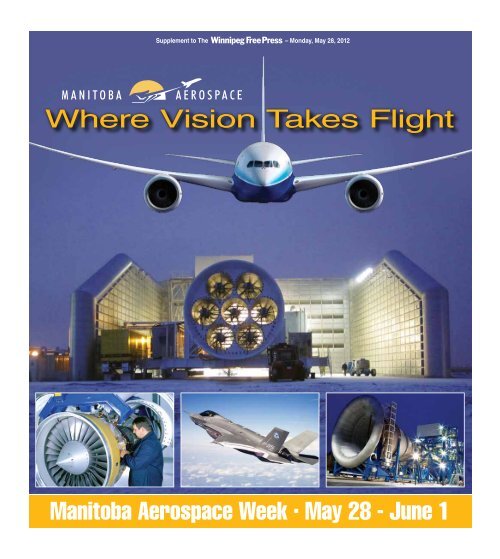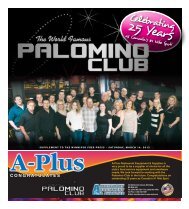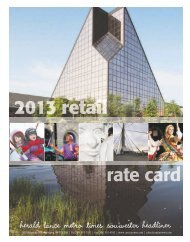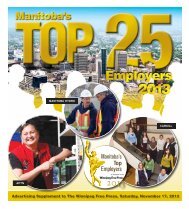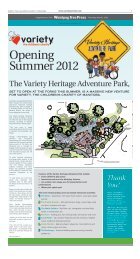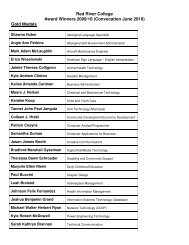2012 Aerospace Week - Manitoba Aerospace
2012 Aerospace Week - Manitoba Aerospace
2012 Aerospace Week - Manitoba Aerospace
- No tags were found...
Create successful ePaper yourself
Turn your PDF publications into a flip-book with our unique Google optimized e-Paper software.
Supplement to The – Monday, May 28, <strong>2012</strong>Where Vision Takes Flight<strong>Manitoba</strong> <strong>Aerospace</strong> <strong>Week</strong> . May 28 - June 1
<strong>Manitoba</strong> <strong>Aerospace</strong> <strong>Week</strong> . May 28 - June 13Messagefrom thePresident<strong>Manitoba</strong>ns can be proud of another successfulyear in our thriving aerospace sector.In spite of a challenging global economy,we were able to thrive due to the diversity ofthe local aerospace industry, which includesmanufacturing, maintenance and repair, flightand technical training.More than 5,000 persons are directly employedin our <strong>Manitoba</strong> <strong>Aerospace</strong> Associationmember companies, creating about $1.5billion in products and services annually.Our talented professionals produce componentsfor the most advanced aircraft, satellitesand unmanned aerial vehicles. Due toour tremendous track record in the industry,<strong>Manitoba</strong> is also widely respected as a centreof excellence for composite materials research,manufacturing and the developmentof repair techniques.The industry is led by three world-class,global firms — StandardAero, Magellan<strong>Aerospace</strong> Limited - Winnipeg (Bristol <strong>Aerospace</strong>),and Boeing Canada Operations Limited.These companies supply leading-edgeproducts and services to customers aroundthe world, and are supported by more than20 established regional and national firmsthat provide a variety of highly specializedproducts and services.The last year has been a busy one as theworld economy continues to recover and thedemand for air travel grows. Boeing CanadaOperations Ltd., StandardAero and Magellan<strong>Aerospace</strong> have all expanded their plantsand/or work scopes.StandardAero is now fully operationalwith their CFM 56 engine line to overhaul theWestJet Airline fleet for the next 10 years. Andin 2011, StandardAero was contracted byGeneral Electric to construct and operate a$50-million jet engine testing and certificationfacility to test GE’s new technology engines.StandardAero engineers, in conjunction withGE experts and excellent local <strong>Manitoba</strong>contractors and tradespersons, completedthis amazing construction project in recordtime. Two new leading edge General Electricengine types have already been tested at thisfacility.Magellan <strong>Aerospace</strong> (Bristol) continuesto build satellites and has added a new134,000-square-foot facility to manufacturecomponents for the new international JointStrike Fighter (JSF) program. Magellan’s investmentof over $100 million will positionthem well to manufacture a billion dollars ofJSF products over the life of that program.Boeing’s new 787 Dreamliner, parts ofwhich are designed and manufactured inWinnipeg, has launched and Boeing CanadaOperations Ltd. continues to invest in technologyupgrades and capabilities. The Winnipegplant is the largest composites manufacturingcompany in Canada and one of thelargest in North America.Our small- and medium-size companieshave also had a busy year and come out ofthe economic downturn with new businessand busy order books. Cormer IndustriesGroup was recently named one of the Top 50Defence Contractors in CanadaOur Research and Development capacityalso continues to grow. The University of<strong>Manitoba</strong> is expanding its Engineer in Residenceprogram and the Composites InnovationCentre moved into a new facility. RedRiver College expanded the Centre for NonDestructive Inspection (CNDI) network andthe Centre for <strong>Aerospace</strong> Technology andTraining (CATT) lab, both of which are industrydriven partnerships. The new GE sponsoredengine test centre has spawned thecreation of a new organization called WestCanitest R&D Inc. (WestCaRD), which is engagedin facilitating the addition of new technologyand equipment to create additionalResearch & Development opportunities. Allof these initiatives will support our industry,bringing more jobs to <strong>Manitoba</strong>.<strong>Aerospace</strong> is a worldwide business and<strong>Manitoba</strong> is competing globally. Despite thefact that the playing field is not always level,<strong>Manitoba</strong> companies continue to compete favourablybecause of the well-trained peoplein our workforce. In addition to attracting,training, and retaining good people, we alsoneed to continue to ‘up our game’ — not onlyin quality, delivery, and cost but also in ouroverall ability to compete and improve productivity.An important new initiative is the CompetitiveEdge company development program— an innovative and robust model to developlocal companies into world-class suppliers.The program, modelled after a highly successfulinitiative for the UK, involves benchmarking,training, mentorship and coaching.Five of our MAA member companies areenrolled (Cormer Industries Group, EnduronCustom, Standard Manufacturers Services,Argus Industries, and Micropilot). By all reports,the Competitive Edge initiative is developinginto a very effective program and isbeing well received by our companies.Looking to the future, we know that therewill continue to be challenges in the world’seconomies and lots of international competition.However, the forecast requirement for30,000 newer, greener aircraft over the next20 years provides tremendous opportunityfor our members, for <strong>Manitoba</strong> and for Canada.The sky truly is the limit for the <strong>Manitoba</strong>aerospace industry.If you’re looking for an interesting, challenging,well-paying career, the aerospaceindustry could be the answer you’re seeking.Look us up!Kevin Bartelson, GM Boeing Canada WinnipegPresident,<strong>Manitoba</strong> <strong>Aerospace</strong> AssociationAre you interested in a career in <strong>Aerospace</strong>?You are closer than you think!The Neeginan Institute of Applied Technology in partnership with <strong>Manitoba</strong> <strong>Aerospace</strong>Human Resources Council, is accepting applications for training programs that can leadto entry level positions in the local <strong>Aerospace</strong> sector. Applicants will need a minimum ofGrade 12 or equivalent as well as successfully complete a criminal record check.We are currently recruiting for aircraft engine repair and machining programs.Starting wages = $14.00 to $18.00 per hour.Applicants must be of Aboriginal Ancestry (Status, Non-Status, Metis or Inuit)For more information contact:Joe Prest<strong>Aerospace</strong> Liaison Officer(204) 949-1493(204) 998-2927 (cell)jprest@abcentre.orgor register for an information session on:Wednesdays at 10:00 amNeeginan Institute of Applied Technology316 – 181 Higgins Avenue(204) 989-7110
<strong>Manitoba</strong> <strong>Aerospace</strong> <strong>Week</strong> . May 28 - June 15This yearMagellan willcelebratethe 50thanniversary ofthe Black Brantrocket programat Bristol. TheBlack Brant isa two-stagesoundingrocket usedby agenciessuch as NASA,and helpedestablishedBristol’sreputation inthe scientificmarket.Continued from Page 4Magellan <strong>Aerospace</strong> is also changing the landscapeof aerospace manufacturing in Winnipeg, as it builds variouscomplex assemblies for the new F-35 Lightning II JointStrike Fighter (JSF) jet, as part of an international consortiumbuilding the airplane.Being part of the JSF program means Magellan’s employeesare implementing new technologies while they areperfecting their processes and techniques to produce thehorizontal tail and other composite assemblies, as well asthe engine vane box and transition duct for the version thatcan perform vertical landings.The Lockheed Martin F-35 Lighting II is a single-seat,single-engine, fifth-generation fighter with stealth capability.It is being built in three models: the conventional model;a short takeoff and vertical-landing model; and a modelintended for use onboard aircraft carriers. Its constructionincludes leading-edge materials, providing a low-maintenancestealth technology aircraft. Composites are used inmany places, with approximately 40 per cent of the aircraft’sstructure by weight made from this high-strength material.According to Lockheed Martin, the F-35 will be fourtimes more effective than legacy fighters in air-to-air combat,eight times more effective in air-to-ground combat, andthree times more effective in reconnaissance and suppressionof air defences — while having better range and requiringless logistics support.Magellan is producing a number of components for theF-35 program. The horizontal tail is the largest and mostcomplex. Magellan is responsible for the manufacturing ofall the internal structure and the skin. The horizontal tail incorporatesaluminum and titanium, but the majority of it ismade out of composite materials.“There will be 1,038 horizontal tails built here,” says Boitson,adding the United States is purchasing the bulk of thejets, with the United Kingdom, Italy, Netherlands, Canada,Turkey, Australia, Norway and Denmark all participating inthe development of the aircraft.The company employs more than 700 people, and producesaerospace components, including aerostructures,aeroengines and the rockets in the space division, accordingto Boitson. Magellan produces aircraft sub-assembliesand engine components for all the major aerospace companies.“Our industry has become a lot more global and we’veexpanded our operations worldwide,” he says. “The job hasbecome more challenging because we’re competing withthe world’s best companies.”That competitiveness means Magellan hires the best engineers,designers and manufacturing people, and puts theright equipment on the floor for them to use, and connectsthem with the right suppliers in Europe and southeast Asia.“We may not be a household name in that we don’t sellconsumer products, but our work is a part of the aerospaceindustry around the world,” says Boitson. “We are in researchvehicles such as rockets, major airplanes have ourparts, and satellites carry our components high overhead.”BRISTOL AEROSPACE IS PROUD TO CELEBRATE MANITOBA AEROSPACE WEEKSERVICE AND INNOVATION HAND IN HANDMagellan <strong>Aerospace</strong> is where innovation and service work hand in hand. It is where advanced technology unites with strategic relationships.We pride ourselves on our ability to understand where our customers are coming from, and where they want to go. We make it our business to alignourselves with our customers’ objectives to make our technology work for their success.
8Where Vision Takes FlightAmbassadorsreach outto studentsANNUAL AAIM DAYA BIG HIT WITH KIDSBy Mike Miguez – For the Free PressBarbara BowenThe idea of an <strong>Aerospace</strong> Ambassador Programwas conceived in the spring of 2011.The purpose of the program was to find and trainrecent graduates working in the local aerospace industrywho were interested in introducing students tocareer opportunities in the aerospace sector throughhands-on workshops at schools and career fairs.“While the aerospace industry has good peoplenow, they are facing the same manpower shortage aseveryone else,” saysBarbara Bowen,special projectsmanager for <strong>Manitoba</strong><strong>Aerospace</strong>Human ResourcesCouncil (MAHRC).“There is a skillsshortage. It’s thedemographics — people are retiring. Part of myresponsibility is to make sure there are people whohave had the training needed to fill those jobs.”The Ambassador Program focuses on students inGrades 7 to 9. Hands-on workshops are held duringschool hours.“The reason we are going after kids in thosegrades is to make them, their parents, and teachersaware that we do have a vibrant aerospace industryright here in <strong>Manitoba</strong>,” she says. “There are greatjobs and world-class training facilities. You can stayright here at home and end up with a fantastic joband a great lifestyle.“The aerospace industry will give you all the trainingyou need. If you put the time and energy in, theaerospace companies will support you.”Right from the start program organizers have hadno problem in finding volunteer ambassadors fromwithin the aerospace companies.“The response has been incredible,” Bowen says.“With very little to go on, because we are all learningas we go along, because it’s brand new, we haveover 30 people on board. When we had our informationsessions we asked them why they were interestedin doing this and the answer was pretty wellthe same from everybody: I love my job and it’s anopportunity to give back.“We have had great response from the big three,StandardAero, Bristol <strong>Aerospace</strong>, and Boeing, aswell as from smaller companies.”Ambassador training began in the fall of 2011. Aprogram specialist has been hired to work with theambassadors in developing the lessons and learningThere are great jobs and world-classtraining facilities. You can stay righthere at home and end up with afantastic job and a great lifestyle.how to work with youth.“One of the most important things to keep in mindwhen you’re trying to get concepts across to youthis the kids have to try it,” says Bowen. “To get theirhands in there. These people are experts in theirfields but they are not necessarily experts in workingwith youth.”In addition to working with the program specialist,the ambassador training involves how to present curriculumin an understandingway andworking together inteams.The ambassadorshave also beeninvolved in brainstormingmeetingsfocusing on what activitiesto include and equipment needed to carry outthose activities.Ambassadors have also been asked to take theinitiative in approaching their local and neighbourhoodschools to inform them of the program.“Some of them have done that and are anxiousto get in and work with their own neighbourhoodschools,” says Bowen. “There has been a fair amountof time put in by the ambassadors.”A pilot project was recently held at Winnipeg’s TecVoc High School involving a number of ambassadorspresenting their hands-on workshops in preparationfor the fall <strong>2012</strong> launch.Organizers are in the process of assessing theresults.“We are very anxious to evaluate how thingswent,” Bowen says.Organizers plan on putting out a late summer,early fall marketing campaign in order to measure theinterest of teachers and schools.Initially the Ambassadors Program will be offeredin Winnipeg and surrounding area.Bowen is excited to see where the program will go.“Absolutely, this is brand new opportunity,” Bowen says.“What’s really exciting for the council when westart these programs is seeing them take on a life oftheir own so that teachers know that if they contactone of the companies they can have someone comein to do hands-on activities with their students.”The Ambassador Program will officially launch inthe fall of <strong>2012</strong>. Interested schools and teachers cancontact the <strong>Manitoba</strong> <strong>Aerospace</strong> Human ResourcesCouncil at 272-2955.Grade six students participate with hands-on activitiesfocusing on flight, aviation and aerospace manufacturingduring AAIM Day. This year’s AAIM Day included studentsfrom Neepawa and Gimli, as well as Winnipeg.The <strong>Manitoba</strong> <strong>Aerospace</strong> Human Resources Council recently heldits annual <strong>Aerospace</strong> & Aviation in <strong>Manitoba</strong> (AAIM) Day at Red RiverCollege — Stevenson Campus.AAIM Day is designed to introduce the various aspects of <strong>Manitoba</strong>’sthriving aerospace and aviation industries to Grade six students and theirteachers.This year’s AAIM Day included students from Neepawa and Gimli,as well as Winnipeg.“The reason we choose grade six is because their science curriculumincludes a module on flight,” says Barbara Bowen, special projectsmanager for <strong>Manitoba</strong> <strong>Aerospace</strong> Human Resources Council(MAHRC), and creator of AAIM Day.“The kids are learning about the theory of flight, lift, and various aspectsof aerodynamics, so we thought what better age group to bring in.”The half-day program involves more than 700 students, broken intomorning and afternoon time frames, participating in hands-on activitiesfocusing on flight, aviation and aerospace manufacturing, over twoplushours.Hands-on activities include: composites — combining differentmaterials to create a lighter, stronger, more fuel-efficient material thansteel; flight inspection on helicopters and aircraft; crater fun — the effectsof meteorites hitting the earth; DC9 theatre — an on-board learningexercise involving the various jobs involved with flying aircraft; aerodynamicsof paper airplanes; and rockets.AAIM Day has received very positive evaluations over the yearsfrom both students and teachers.“The biggest complaint we get from the kids is it’s too short,” Bowensays.“In my opinion, if you have kids asking for more, it’s been a success.”The popularity of the program has grown so much the MAHRC doesnot do any regular marketing other than the occasional presentation atscience teacher’s in-service days.The program has taken on a life of its own by word-of-mouth.“We are extremely pleased to see how the program has developed,”Bowen says. “We have an absolutely fantastic team working on thisprogram.”
<strong>Manitoba</strong> <strong>Aerospace</strong> <strong>Week</strong> . May 28 - June 19Competitive Edge program offerscompanies detailed map to successBy Pat St. Germain – For the Free Press<strong>Manitoba</strong> <strong>Aerospace</strong> wants its membersuppliers to reach for the stars. And it isoffering them a boost with the CompetitiveEdge Supplier Development Program.A pilot project modelled on a successfulprogram in the UK, Competitive Edge helpscompanies clarify goals and create detailedblueprints for success, starting with assessmentsthat give them a benchmark score on11 foundational processes, including innovation,project management and e-business.There are five rungs on the benchmarkladder: Learner, developer, performer, contenderand world-class organization.Companies get a clear picture of wherethey stand on each of the foundational processesand, with training and coaching, developa step-by-step strategy for moving upthe ladder on two or three processes theychoose to improve upon.“It’s a very structured approach to helpingan organization develop a vision for wherethey want to go and a detailed map as tohow they’re going to get there,” says <strong>Manitoba</strong><strong>Aerospace</strong> Human Resources Councilexecutive director Wendell Wiebe.Wiebe says the value of the project is inthe journey. He says it’s impossible to reachthe world-class step because it’s constantlymoving.“The definition of world class changesall the time because companies are havingto be more efficient in order to please theircustomer.”The program, which is supported byWestern Economic Diversification Canadaand Industry Workforce Development, isopen to all manufacturers in Western Canada,but its initial focus is on <strong>Manitoba</strong> <strong>Aerospace</strong>’ssmall and mid-size member companies.The big three companies — StandardAero,Boeing Canada Operations Ltd. andMagellan <strong>Aerospace</strong> (Bristol) — already havemany of the key systems in place. But they’vebeen asked to participate by providing mentorswho spend a few hours each week witha smaller company’s executive team.Five companies have joined the programso far. Cormer Group Industries, EnduronCustom Inc., Argus Industries and StandardManufacturers Services signed on in March2010, and Micropilot joined in March 2011.The companies pay a portion of all costs,but Wiebe says the biggest commitment istime. For example, if a company needs toimprove in the area of project management,key employees must take training and thenevaluate their organization to see how theycan apply the principles of project managementto all their operations, with assistancefrom a mentor and follow-up evaluation froma program steering committee.<strong>Manitoba</strong> <strong>Aerospace</strong>Human ResourcesCouncil executivedirector WendellWiebe (above) saysthe CompetitiveEdge program helpscompanies createdetailed blueprintsfor success. StandardManufacturersServices vicepresidentofoperations KimGretschmann (right)says the program hasalready paid off forher busy company.“As an executive, you’re committing yourtime that you’re going to develop these businessprocesses within your plant, and soany time you’re introducing some changeinto an organization it usually takes a lot ofextra energy because it’s something on topof just running the business,” Wiebe says.Standard Manufacturers Services vicepresidentof operations Kim Gretschmannsays making that commitment has alreadypaid off for her busy company, which designsand develops prototypes and has analuminum foundry to make and machinemetal castings for planes, trains and automobiles.“There’s so much going on all the timeand that’s what makes this program strongis because it provides that focus. You canget busy doing a bunch of little things thatdon’t really help you overall, but the programactually gets you to focus in a structuredmanner to collect the data that you need tomake a difference on.”Standard Manufacturers Services choseto focus on three foundational processes —leadership, strategic business planning andlean, a process that eliminates waste andimproves operational efficiency.The initial benchmarking assessmentidentified gaps and mapped out specificsteps the company hadto take to reach its goals.Gretschmann is confidenta second benchmark assessmentthis Septemberwill show improvement.“You’re always wantingto go to that next step, butfinding that roadmap justclarifies it and makes yousee the forest for the treesso to speak,” she says, addingthat having mentorshipmay be the most valuablecomponent to the program.“The mentorship elementprovides us with ongoingsupport that wouldn’totherwise be available,and they inherently insertinfluence, accountability,credibility and, of course,leadership into the processthat supports our entiremanagement team,” shesays.“The bottom line for theentire program is probablythe transfer of knowledgethat is embedded andshared for the best practice.”Wiebe says some componentsof the program arestill evolving. It’s using expertisefrom the UK modelfor some of the foundationalprocesses, but is graduallyidentifying more local supplierswho can deliver trainingand coaching.He says the five companiesin the program haveseen improvements in performance, andCompetitive Edge wants to bring more companiesonboard.Gretschmann says the decision to jointhe program should be easy.“It helps people be better at what youhave to be better at, because you really haveno option. Quality has to be there, safety hasto be there, production efficiency has to bethere, and so it’s really helping you do whatyou have to do anyway.”PHOTOS BY DARCY FINLEY
10Where Vision Takes FlightU of M, Red River College help preparestudents for careers in aerospaceBy Liz Katynski – For the Free Press10TH ANNIVERSARYAIR FAIRFree to the Public – All WelcomeIn honour of the 10th Anniversary ofRed River College Stevenson Campus,we are pleased to invite the public tojoin us for a very special showcaseof private, commercial, military andheritage aircraft.SATURDAY, JUNE 2, <strong>2012</strong>10:00 am – 4:00 pmRed River CollegeStevenson Campus2280 Saskatchewan Ave.FeaturingAircraft Display and Fly BysF18 Hornet, Boeing 727, Douglas A26Invader, and many more! Unique display ofhome-built aircraft – come talk directly tothe owners who build and fly these aircraftAircraft subject to change• FOOD CONCESSION• FREE PARKING• ALL WELCOMEFor information contact204.945.6001 orstevensonaviation@rrc.mb.caTraining and education are importantcomponents in <strong>Manitoba</strong>’s growing aerospaceeconomy.A big part of the innovation and productivitysolution for industry is having a highqualityworkforce, and <strong>Manitoba</strong> is fortunatebecause it has the human resources todrawn on from both the University of <strong>Manitoba</strong>and Red River College.Big things are happening at the U of M,which will soon add a second Engineer inResidence position for a mechanical engineerwith aerospace option.The Engineer in Residence is a professionallead for the university’s aero designteam that works on team-based studentprojects.The world’s aviation industry is benefiting from theoperation of a first class Global <strong>Aerospace</strong> Centerfor Icing and Environmental Research (GLACIER)in Thompson, <strong>Manitoba</strong>. MDS AeroTest ismanaging, operating and maintaining the GLACIERfacility, providing employment opportunities for avariety of skill sets, including several disciplines inhigh-tech aviation. The facility is a ground-basedopen air test stand capable of testing a very widerange of gas turbine engines. As an engine-genericinstallation, it includes the infrastructure and testsystems necessary for the introduction of bothcurrent and future aircraft engines. The sub-arcticweather conditions of Thompson, <strong>Manitoba</strong>, makeit an ideal location for outdoor icing tests, lowtemperature endurance testing, cold soak, andother adverse weather testing of flight vehicles andtheir propulsion systems. During the off season,the facility also provides ideal conditions for otherperformance, endurance and operability testing.Careers:MDS AeroTest has an immediate requirement fora Quality, Environment, and Health & SafetyRepresentative.MDS AeroTest is accepting resumes for futureconsideration for Engine Test Operators.For more details on the requirements for thesepositions, please visit http://mdsaerotest.caMDS Aero Support has an immediate requirementfor an Instrumentation and Controls Technologistto be based in Thompson but will split their time80% in Thompson and the balance supporting theOttawa office or a client site.For more details on the above requirement, pleasevisit http://mdsaero.comWe thank all applicants for their interest, however,only those candidates who meet or exceed ourrequirements, are legally eligible to work in Canadaand do not require sponsorship are invited to submittheir resume in confidence to hr@mdsaerotest.com.No telephone calls please – we are not able torespond to telephone inquiries.A student uses a robotic welder at Red River College’s Centre for <strong>Aerospace</strong> Technologyand Training (CATT), located at StandardAero. Many of RRC’s manufacturing technicianand technology students will spend time in the lab each term.Recently, the team placed second in theworld at the Society of Automotive Engineers(SAE) <strong>Aerospace</strong> Competition in Atlanta.“The winners, from Brazil, beat us by lessthan one point,” says Jonathon Beddoes,dean, Faculty of Engineering, at the U of M.“That’s a very strong indication of the calibreof our students and our program.”In another competition, the Canadian SatelliteDesign Competition, students designedand built a satellite. They are currently in firstplace in the second round of judging. Thefirst-place winner will be announced in Ottawain September. If they win, their satellitewill be launched into space and this will bethe first time a U of M student-designed satellitemakes it to space.“These are just two examples of the largeteam projects by students,” says Beddoes.“U of M’s aerospace-related training is keptcurrent and relevant through the advice ofthe <strong>Manitoba</strong> <strong>Aerospace</strong> Engineering LiaisonGroup (MALEG). It includes representationfrom the <strong>Manitoba</strong> <strong>Aerospace</strong> Association,Boeing, StandardAero and Magellan.“They help us ensure we provide students withwhat they need as they move into the industry.”The University of <strong>Manitoba</strong> is the top supplierof engineers in <strong>Manitoba</strong>, supplying 85 percent of all engineers working in the province.<strong>Aerospace</strong> is an area where engineers havemany opportunities to meet technical challengesand make a difference, says Beddoes.“<strong>Manitoba</strong> has the two most advancedcold-weather aero engine testing facilities inthe world — WestCaRD at the Winnipeg airport,and Glacier in Thompson. We work inclose collaboration with them.”Red River College continues to moveahead in preparing students for careers inthe aerospace industry. The college’s industrialcampus is a new, award-winning way tohave students learn the latest technology asthey apply it to real-life projects.This ‘campus within industry’ — with theschool’s equipment located at StandardAero,is the first of its kind in Canada, and has beentoured by many educators and industry engineers,who are inspired by the idea andwant to learn more about how it was accomplishedand how it works.Known as the Centre for <strong>Aerospace</strong> Technologyand Training (CATT), it started in 2009and many of RRC’s manufacturing technicianand technology students will spend timein the lab each term. About 15 have workedon applied research projects on their co-opplacements or as interns.“StandardAero provides the facilities andmaintenance and we provided $5 millionworth of equipment with support from WesternEconomic Diversification and the federal andprovincial governments,” says Don MacDonald,dean, School of Transportation, Aviationand Manufacturing at Red River College.Continued on Page 13
<strong>Manitoba</strong> <strong>Aerospace</strong> <strong>Week</strong> . May 28 - June 111StandardAero boldly embarksinto its next century of serviceFor the Free PressSince celebrating its 100th anniversarylast year, StandardAero’s next century of serviceis continuing with a number of significantachievements, milestones and celebrationsat its Winnipeg facilities.One of those accomplishmentswasmarked by the company’s10-year anniversaryas a GEauthorized CF34 engineservices provider,and the last threeyears as a GE DesignatedFulfillment Centrefor CFM56 enginemaintenance.This year, StandardAeroreached anamazing milestoneby completing a combinedtotal of 1,000CF34 & CFM56 engines.The 1,000th unitdelivered was a CF34-3 engine for long-timecustomer, Brit Air.To celebrate thisachievement, thecompany announcedthis historical eventexternally at a majorEuropean trade showon May 14, in Geneva,Switzerland.Brit Air is one ofStandardAeros’s firstCF34 customer outside North America andthe company’s long-term partnership withthem has strengthened its presence in theEuropean market as well as extended itsglobal footprint. StandardAero’s reputationfor quality, reliability, turn-time and customerservice has been recognized through its relationshipwith Brit Air, as have many otherlong-term partnerships with companies suchas GoJet, Atlantic Southeast Airlines, Embraer,Cimber, Alitalia, WestJet, and SkyWest.Marking another significant achievementthis year, on Feb. 1, General Electric, StandardAero,the Winnipeg Airport Authority andWestCaRD hosted a gathering of local politicians,VIP’s, educators, aerospace industryexecutives and the media to tour and participatein ceremonies to officially open the GeneralElectric Testing, Research and DevelopmentCentre (TRDC).The event marked the successful conclusionof a very large-scale project for StandardAeroand signifies the start of a long-termrelationship with GE in the area of new enginedevelopment.GE selected to build this new facility atthe James Richardson International Airport,in conjunction with StandardAero. The selectionof Winnipeg and StandardAero wasdue to many factors, including the excellentrelationship GE has with StandardAero, thefavourable conditions in Winnipeg for icingtests and the proximity to a skilled workforcein the area of gas turbine engine testing.After several months of environmentalstudies on several sites in and around theairport and several months of conceptual design,construction of the facility commencedon April 26, 2011.With an expanded scope from GE to builda facility rated to test the largest engines inthe world, StandardAero’s Facilities Engineeringteam was engaged to design andmanage the facilities project. The timeline forthe project was extremely aggressive as GEchallenged StandardAero to have the facilityready to perform icing certification tests duringthe 2011-<strong>2012</strong> test season in Winnipeg.StandardAero, a GE authorized CF34 engine services provider, reached an amazing milestone this year by completinga combined total of 1,000 CF34 & CFM56 engines. The 1,000th unit delivered was a CF34-3 engine for long-time customer,Brit Air. Staff members celebrated the achievement with a group shot.With the task of building a facility of such sizein such a short period, the team accepted thechallenge and started on the journey to completethe facility to meet GE’s deadlines.Seven months after site mobilization at theJames Richardson International Airport, theteam was able to declare substantial completionof the facility. This milestone did not arrivewithout a lot of hard work by both StandardAeroemployees and the many tradesand sub-trades employed by StandardAerothroughout the project. Following are some ofthe construction highlights:• More than 17,000 engineering designand project management hours over thecourse of the project;• Up to 200 contractors at the job site atany given time;• Five months to complete the94,500-square-foot foundation;• 330 caissons drilled and poured for thepad foundation — 45 of the caissons werefive feet in diameter under the test stand;• The thrust stand was embedded into theconcrete (six feetthick) on Aug. 9;The completedfacility has becomethe world’s leadingengine test certificationcentre with asignificant amountof capability andnew technology incorporated.The single poststand utilized at thefacility, at a totalheight of 56 feet,is only one of threearound the world.The stand and thesurrounding foundationwere designedto withstandthe extreme occurrenceof a verylarge engine bladeout event. The facilityalso incorporatedthree noiseattenuation walls ata height of 51 feetto reduce and limitthe sound of largeengines tested atthe site.In addition, thenoise attenuation package includes a 16-foot translating augmenter tube and a 51-foothigh exhaust tower. The facility also incorporatesa 100-foot rail system which will move aplatform that holds one million pounds of thewind tunnel and associated services to runan icing test.The movement of the tunnel and serviceswill enable the facility to be used for additionaltesting in the areas of ingestion, hailstorm,endurance, and mixed phase testing.StandardAero has officially become partof the engine certification process with GE.Over the next five years, GE will have a significantamount of new engine platforms thatwill utilize the facility for certification tests.StandardAero continues to see a bright futurein Winnipeg and in the global aerospaceindustry, and the company is looking forwardto its next century of service.
12Where Vision Takes FlightComposite research centre spreads wingsBy Jim Johnson – For the Free PressThe Composites Innovation Centre (CIC)in Winnipeg is growing, prompting a recentmove into a much larger facility, which canonly mean good news for the province’s expandingaerospace industry.Since it was formed in 2003, the CIC hasgrown to become the largest not-for-profitcomposites research facility in the country— heady stuff considering it first opened itsdoors in 2003. And much of that growth hasto do with the work it has done,and continues to do at an acceleratedpace, with the aerospaceindustry.Sean McKay, the CIC’s executivedirector, says the growinginterest in bio-materials and traditionalcomposites for the aerospaceindustry has kept the centrebusy with a growing number ofprojects. About 30 per cent of thework done by CIC is in the aerospaceindustry.“We work closely with our majorclients like Boeing, Magellanand Cormer Group Industries,”says McKay, who has held theposition since the inception ofCIC. “We have some projects weare working on to support Magellanin qualifying their facilitiesfor producing parts for the F-35aircraft, as well as assisting introubleshooting the introductionof new product for getting thataircraft on the shop floor.”McKay says CIC also is implementinga program to transfer engineersinto the facility tosupport cross-traininginitiatives and developingresourcepools that can beused for large projects.“For example, ifBoeing gets a largecontract,” he says,“It would have a largerresource poolin the community todraw on to work onthat program.”The CIC was thedriving force behindthe establishment,and is the co-ordinator,of Canadian Composites ManufacturingR&D Inc. (CCMRD), a national aerospace industry-focused,pre-competitive technologydevelopment and demonstration researchconsortium, and also plays a similar role inthe operation of a bio-fibres initiative. It worksglobally with different countries to implementresearch centres to support the developmentof new technologies.The consortium has grown to 11 members,including Bell Helicopter, Bristol <strong>Aerospace</strong>,Cormer Group Industries Inc. and BoeingCanada Operations Ltd. Technology WinnipegDivision. Boeing Canada Operations Ltd.’sU.S.-based research and technology divisionsits on the board and is an active participant.CIC is a non-profit corporation that’sfunded partly by industry, but primarily by theprovincial and federal governments throughthe Western Economic Partnership Agreement(WEPA).Its main focus is to support the compositesmanufacturing industry in developingand growing their businesses.McKay said the CIC is becoming worldrenownedfor its work in the development andThe Composities Innovation Centre (CIC) moved from its 6,000-square-footbuilding at the University of <strong>Manitoba</strong>’s Smartpark to a 21,000-square-foot locationat Tuxedo Business Park in southwest Winnipeg (above). The CIC is becomingworld-renowned for its work in the development and commercialization of naturalfibre materials used in composite structures.Since it was formed, theCIC has grown to becomethe largest not-for-profitcomposites research facilityin the country — headystuff considering it firstopened its doors in 2003.commercializationof naturalfibre materialsusedin compositestructures.P l a n twastes from food productionand forestryoperations can bepressed and mouldedinto car parts, and potentiallyaircraft piecesand building materialsthat are lighter, less expensive and just asstrong as fibreglass.At the same time, these materials eat upless energy in the manufacturing process.And a lighter vehicle — be it a car, a bus, or aplane — uses less fuel, which in turn is betterfor the environment.CIC is not alone in the bio-materials field inCanada, but it is somewhat unique.“Others in Canada do the research component,”says McKay. “We are closer to thecommercialized end of things. We work directlywith our clients to develop technologiesand investigate alternate materials that canbe used and transferred over toindustry to improve products ordevelop new products.”CIC will also work on existingproducts where there is a requirementfor a class-weight advantage.McKay says CIC identified theneed for a new facility a few yearsago.“For the past three years we’vebeen working to see how we cancoordinate the funds and supportwe need to build it,” he said. “Weneeded to provide a prototypeshop that allows us not only to designthe part in-house, but to fullyproduce prototype parts from thecomputer-aided design drawing,all the way through to manufacturingthe end part that’s ready fortesting and trialing with ourcustomer.”CIC has since movedfrom its 6,000-square-footbuilding at the Universityof <strong>Manitoba</strong>’s Smartparkto a 21,000-square-foot locationat Tuxedo BusinessPark in southwest Winnipeg.McKay says the newspace will mean CIC willhave room for training inpartnership with Red RiverCollege and the U of M.McKay expects staff atthe centre to grow to 30from the current 22 by the beginning of 2013.“We have developed in an era where government,both provincially and federally, seethat with innovation you can improve productivityand therefore grow the manufacturingsector,” says McKay. “We’re an enabler ofthat type of policy.“The growth has come because we’re inthe right place at the right time.”SEAN McKAY— with files fromthe Winnipeg Free Press
Ken WebbExperiencea big resourcefor Webb, MAAKen Webb could probably have had hispick of places to live and work after his educationwas done.But after receiving his Engineering degreefrom the Royal Military College in Kingston,Ont., and his Masters of Engineering fromthe University of Canterbury in Christchurch,New Zealand, he preferred to stay close to hisroots and came home to Winnipeg.Today, after a full and robust career, he’sthe new executive director of the <strong>Manitoba</strong><strong>Aerospace</strong> Association, and committed tomoving the industry in this province forward.“Winnipeg is such a great place to live,work and play,” says Webb. “We have beenfortunate to live and work in a number ofplaces, and to have travelled through manyparts of the world, and that has given us greatperspective and an appreciation for howgreat a place <strong>Manitoba</strong> is. We consider ourselvesvery lucky to have been able to comeback home, raise our family, and have a numberof rewarding careers here.”Webb’s own background prepared himwell for his role. He recently retired from a 22-year career at Red River College, where hebegan as the Dean of Technology and laterbecame Vice-President, Academic & Research.Prior to Red River College, he developedextensive experience in engineering designand management, and he spent 10 years withthe Department of National Defence.He has a strong understanding of how research,education and training drives innovation,and how it all comes together to supporta competitive, world-class industry whichprovides high-tech, highly-paid jobs for thecoming generation of <strong>Manitoba</strong> youth.“As a leader in the Canadian post-secondarysystem, I developed a strong understandingof globalization, the rise of the knowledgeeconomy, what it takes for industry to becompetitive, the importance of research anddevelopment, and how innovation drives theproductivity improvements Canada needs,”he says. “A big part of the innovation and productivitysolution for industry is having a highqualityworkforce, and creating that workforceis a major part of the college’s mission.“The aerospace sector is one of the strategicsectors that RRC focuses on, and is oneof the college’s largest partners. While at RRCI worked with most of the aerospace companiesand all the major supporting partners andagencies at all levels of government, at theuniversities, at Apprenticeship <strong>Manitoba</strong> andin the trade and professional associations.”Paul Heide, former president of the <strong>Manitoba</strong><strong>Aerospace</strong> Association, was thrilled tohave Webb take over the role.“Red River College is an integral educationalpartner and training facility for the aerospaceindustry,” he says. “We are delightedto welcome Ken and look forward to his knowledgeand ideas.”Webb says <strong>Manitoba</strong> is well positioned toexcel in the aerospace industry.“We (MAA) tend to collaborate muchmore than we compete,” he says. “We’re bigenough to play on the world stage, and smallenough to get all the private and public sectorleaders around a single boardroom table. Wework together to build a strong industry.“It also helps that the world’s aerospacemarkets are expanding, and much like the<strong>Manitoba</strong> economy in general, we are diversifiedacross a broad range of aerospace activities,so that challenges in one area can beoffset by opportunities in another.”<strong>Manitoba</strong> <strong>Aerospace</strong> <strong>Week</strong> . May 28 - June 1U of M, Red River CollegeContinued from Page 10StandardAero uses the equipment a fewdays a week and Red River students haveaccess a few days per week. Other aerospaceand manufacturing companies canalso have access. “We all benefit,” saysMacDonald. “It’s all beenvery busy and very exciting.We have a great partnershipwith StandardAero.”As a result, RRC graduatesare coming to theirjobs with great confidence,he says. “They are walkinginto their workplaces ableto help companies understandwhat’s possible.”Phase one of CATT focusedon automated laserwelding,cutting and claddingof components withcomplex geometries and gas vapour phasecleaning and coating of gas turbine engineparts. Phase two was an expansion to addautomation, including robotics and rapidprototyping for plastics. Phase three, stillunder consideration, will add rapid prototypingfor metals.Students from a number of programs willbenefit from the industrial campus, includingMechanical Engineering Technology,www.emteq.comSUPPORTING AVIATION GLOBALLY WITHENGINEERING, CERTIFICATION & MANUFACTURINGAvionics and Electrical System DesignStress and Damage Tolerance AnalysisSpecialty Structures & Mechanical SystemsInterior & Exterior LED Lighting13Manufacturing Technician, Composites andManufacturing, and Technology Managementprograms.CATT has been recognized with twoawards: the <strong>Manitoba</strong> <strong>Aerospace</strong> All-StarAward 2010 from the<strong>Aerospace</strong> isan area whereengineers havemany opportunitiesto meet technicalchallenges andmake a difference.<strong>Manitoba</strong> <strong>Aerospace</strong>Association, and theJohn Convey InnovationAward 2011 fromASM International andASM Canada Council.RRC has alsoopened a second industrialcampus calledthe Centre for Non-Destructive Inspection(CNDI). This one is inpartnership with Magellan,StandardAero andthe Composites Innovation Centre and involveslaser ultrasonics, x-ray tomographyand other cutting edge technologies.Red River College’s Aviation and <strong>Aerospace</strong>Strategic Council meets three timesa year to discuss industry changes and howto keep programs relevant. RRC, throughthe <strong>Manitoba</strong> <strong>Aerospace</strong> Human ResourcesCouncil, provides companies with trainingfor their existing employees.The GLACIER/EnviroTREC facility in Thompson is a majorcomponent of <strong>Manitoba</strong>’s claim to be the icing certification capital ofthe world for large gas turbine engines. This globally unique facilityhas been operational since November 2010 and has completedseveral icing certification programs.EnviroTREC, is a not-for-profit sister organization to GLACIER.EnviroTREC’s purpose is to stimulate and mentor collaborativeresearch and development activities and to promote the developmentof human resources necessary to support aerospace technologydevelopment in <strong>Manitoba</strong>. A priority for EnviroTREC is thedevelopment of technologies and skills related to the test, evaluationand certification of the next generation of large aircraft engines.Please visit the EnviroTREC website at www.envirotrec.ca for more information.25 Dunlop Ave., Winnipeg, MBph: 204-783-5402Aircraft Improvement KitsFlammability TestingPROUD TO BE A PART OF THEMANITOBA AEROSPACE INDUSTRY!
14Where Vision Takes FlightGreetingsfrom the HonourableLynne YelichMinister of State forWestern Economic DiversificationMemberCompaniesACS-NAI Ltd.Advanced Composites StructuresAero Recip (Canada) Ltd.Allied Wings — Canada Wings AviationTraining CentreArgus Industries Ltd.Boeing Canada Operations Ltd.Cadorath PropellerCanadian PropellerCarlson Engineer CompositesComposite Technology Inc.Cormer Group Industries Ltd.Custom Steel ManufacturingDynamic MachineEnduron Custom Inc.FastAir Executive Aviation ServicesFlightcraft Maintenance ServicesKeewatin AirMagellan (Bristol) <strong>Aerospace</strong>MicropilotStandardAeroStandard Manufacturers ServicesI am pleased to extend greetings to everyonecelebrating <strong>Aerospace</strong> <strong>Week</strong> in <strong>Manitoba</strong>.<strong>Manitoba</strong> is home to the largest aerospaceindustry in Western Canada and the third largestin the country. The industry is a major contributorto the Canadian economy with revenuesexceeding $1.6 billion annually.Our Government recognizes the strategicimportance of <strong>Manitoba</strong>’s aerospace sector tocreating jobs, growth and prosperity. WesternEconomic Diversification Canada (WD) hassupported several projects that have solidified<strong>Manitoba</strong>’s place on the world stage of aerospaceexcellence:• Advanced Technologies for the <strong>Aerospace</strong>industry including the engine testing andresearch facilities at Glacier/EnviroTREC locatedin Thompson and the WestCaRD testingfacilities in Winnipeg. Together the workcarried out at these two facilities will position<strong>Manitoba</strong> as a world leader in cold weathertesting.• Centre for Non-Destructive Inspection Technologies(CNDI) – provided industry with accessto specialized non-destructive inspectionequipment for training and technologyadoption purposes.• Centre for <strong>Aerospace</strong> Training and Technology(CATT) – enabled Red River College tocreate an off-site industrial campus and provideindustry with a hands-on training environment.• Composites Innovation Centre – home of theadvanced composite development initiative,which assists companies in developing andcommercializing new composite materialsand technologies.On behalf of the Government of Canada, IThank You to ourMembers and PartnersASSOCIATEMEMBERSAcklands GrangerComposites Innovation CentreDeloitteDelude, Taylor Inc.EnviroTRECHindTech CanadaIndustrial Technology CentreInvestors GroupLegacy Bowes GroupNational LeasingSouthport Inc.Tarry & AssociatesThompson UnlimitedWinnipeg Airports Authoritywould like to offer my best wishes to the <strong>Manitoba</strong>aerospace industry for a successful week.I look forward to our continued collaborationand combined efforts to strengthen the aerospacesector in <strong>Manitoba</strong> and across the West.Together, we are building a stronger West fora stronger Canada.Message del’honorableLynne YelichMinistre d’État à la Diversificationde l’économie de l’Ouest canadienJe suis ravie de saluer toutes les personnesqui participent à la Semaine de l’aérospatiale au<strong>Manitoba</strong>.L’industrie de l’aérospatiale du <strong>Manitoba</strong> estla plus grande de l’Ouest canadien et la troisièmeen importante au pays. Cette industrie,qui génère plus de 1,6 milliard de dollars derevenus annuels, contribue énormément à lavigueur de l’économie canadienne.Notre gouvernement est conscient del’importance stratégique que revêt le secteurde l’aérospatiale du <strong>Manitoba</strong> dans la créationd’emplois, la croissance et la prospérité. Diversificationde l’économie de l’Ouest Canadaa soutenu plusieurs projets qui ont renforcé laSUPPORTINGPARTNERSDept. Foreign Affairs& International Trade (DFAIT)Economic DevelopmentWinnipegFaculty of EngineeringU of <strong>Manitoba</strong><strong>Manitoba</strong> <strong>Aerospace</strong>Human Resources Council<strong>Manitoba</strong> EntrepreneurshipTraining & TradeRed River College— Stevenson CampusWorld EconomicDiversification Canadaposition du <strong>Manitoba</strong> sur la scène internationalede l’excellence en aérospatiale.• Des technologies de pointe destinées àl’industrie de l’aérospatiale, y compris les installationsde recherche et de mise à l’essai demoteurs d’EnviroTREC/Glacier, à Thompson,et le centre d’essais de WestCaRD à Winnipeg.Les travaux accomplis dans ces deux installationspermettront au <strong>Manitoba</strong> de devenirun chef de file des essais par temps froid.• Centre for Non-Destructive Inspection Technologies– il permet à l’industrie d’avoir accèsà un équipement spécialisé d’inspection nondestructive aux fins de formation et d’adoptionde technologie.• Centre de formation et de technologie enaérospatiale – il s’agit d’un campus industrieldu Collège Red River offrant un lieu deformation pratique à l’industrie qui est situé àl’extérieur du collège.• Composites Innovation Centre – il est le siègeprincipal de l’initiative de mise au point decomposites de pointe, qui aide des entreprisesà concevoir et à commercialiser de nouveauxmatériaux composites et des technologiesdes composites novatrices.Au nom du gouvernement du Canada,j’adresse tous mes vœux de réussite à l’industriede l’aérospatiale du <strong>Manitoba</strong> durant cette semainespéciale. Je compte poursuivre notre collaborationet nos efforts collectifs en vue de renforcer le secteurde l’aérospatiale tant au <strong>Manitoba</strong> que dans l’Ouest.Ensemble, nous travaillons à renforcerl’Ouest pour édifier un Canada plus fort.
Big plans, high hopesTraining and education arealso important componentsin the aerospace economy.There is a wide variety of careersavailable, including engineering,engineering techniciansand technology, testprogram specialists, CNCoperators, welders and otherskilled trades, composite fabricators,quality assuranceinspectors, international business,sales and marketingand project managers.For career links check out;http://www.manitoba-aerospace.mb.ca/careers/index.htmlEstablished in 1992, the<strong>Manitoba</strong> <strong>Aerospace</strong> HumanResources Council (MAHRC)assists industry andeducational institutionsto develop anddeliver training forexisting and prospectiveemployees.Partnering with federaland provincialdepartments andindustry, MAHRCco-ordinates the developmentand deliveryof training tomeet the needs of localaerospace companies.Since 1992, thefederal and provincialgovernments andindustry, in partnership,have investedmillions in <strong>Manitoba</strong>Continued from Page 2Winnipeg’s aerospace sectoris one of the fastest growingin Canada, with revenuesgrowing by 47 per centbetween 2005 and 2010.aerospace trainingprograms. The resultshave been remarkable,with morethan 1,150 courses created and morethan 7,500 persons trained.“Major companies are fosteringlinks with Winnipeg schools such asTec Voc and Murdoch MacKay aswell as with colleges and universities,”says Webb. “There is an <strong>Aerospace</strong>Ambassador program which sendsindustry people into schools to explainwhat they do and answer questionsabout future careers in the aerospace industry.”He also notes the University of <strong>Manitoba</strong>has a strong engineering school andhas recently created a second engineer inresidence position with a focus on enginetechnology and testing.Wendell Wiebe, Executive Director andgeneral manager of the <strong>Manitoba</strong> <strong>Aerospace</strong>Human Resource Council, nowcelebrating its 20th birthday, says he hasno doubt aerospace has a healthy future.“It’s estimated 30,000 new planes willbe needed in the next two decades,” hesays. “These will come from Boeing, Airbus,Bombardier and others as traveldemand grows in emerging economies.This is a major challenge and opportunityfor many <strong>Manitoba</strong> companies, whether<strong>Manitoba</strong> <strong>Aerospace</strong> <strong>Week</strong> . May 28 - June 1The <strong>Manitoba</strong> aerospaceindustry boasts twoof the world’s mostadvanced engine testingand certification facilities(above). Left, a nozzleinspection for the A380 AirBus is conducted at Bristol<strong>Aerospace</strong> in Winnipeg.supplying components for newaircraft or maintaining and overhaulingthem.”Wiebe says encouragingyouth to enter the industry asolder members retire will beimportant so that skills can bepassed on. In addition, he sayslocal companies need to addvalue and stay highly competitive whichis why they are promoting the CompetitiveEdge Supplier Development program,based on a British model.Assessors benchmark a companyagainst the best. Companies enrollingin the program benefit from a robustand systematic program to develop andimprove their company as a supplier.Help includes:· Training and coaching support· Assignment of a mentor from a largecompany in the industry· Frequent process assessments to keepmotivation on trackSo far Wiebe says the program is provingvery successful and keeping supplierson their toes.Global demand in aircraft is growing atan accelerated pace, as fleets age andrising economies in India, China, the FarEast and other places create new airtravellers.Over the next 20 years, this demand willrepresent a need for more than 30,000new aircraft and a market opportunityof three trillion ($3,000 billion) dollars.Making the right choices now andforging solid partnerships will allowCanada to build on its competitive edgein aerospace. The Canadian aerospaceindustry is poised to grow its market sharethrough the optimization of research anddevelopment spending and the timelycommercialization of technologicalbreakthroughs. The <strong>Manitoba</strong> industry isa good example of this.Thanks to outstanding aerospaceinnovators, solid R&D partnershipswith governments, academia and theextraordinary talent of our workers,Canada has traditionally punchedabove its weight in aerospace and ispositioned to do so into the future.Consider this:· The Canadian aerospace industryis composed of more than 400 firmslocated from Newfoundland to BritishColumbia. It generates in excess of$23 billion in annual revenues throughits global reach.· <strong>Aerospace</strong> in Canada is directlyresponsible for the creation of morethan 80,000 value added jobs forCanadians from coast-to-coast.· <strong>Aerospace</strong> is a direct and significantcontributor to Canada’s balance oftrade: more than 82 per cent of ouroutput is exported.· With annual investments of more than$1 billion each year, aerospace isamongst Canada’s largest contributorsto Canadian R&D activities.· The Canadian aerospace industry isranked fifth amongst its global peers.It is a world leader in market segmentssuch as regional aircraft, flightsimulators, small gas engines, roboticsand satellite technologies, aircraftmaintenance, repair and overhaul, andlanding gear systems.15Key Factson Canada’s<strong>Aerospace</strong>Industry
At Boeing Winnipeg, we’re proud to be the largest compositemanufacturer in Canada and a leading-edge, tier-onesupplier to the revolutionary 787 Dreamliner. We’re equallyproud to be a top employer and vital member of the greater<strong>Manitoba</strong> community, celebrating more than 40 years ofbuilding innovation and opportunity across Canada.


